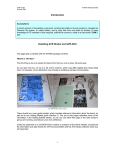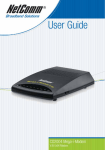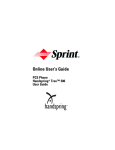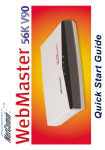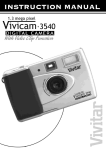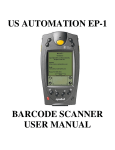Download Palm m105 Getting Started Guide
Transcript
Getting Started with the Palm™ m100 Series Handhelds Copyright Copyright © 2000 Palm, Inc. or its subsidiaries. All rights reserved. Graffiti, HotSync, Palm, PalmConnect, and Palm OS are registered trademarks of Palm, Inc. or its subsidiaries in one or more countries. The HotSync logo and the Palm logo are trademarks of Palm, Inc. or its subsidiaries. Other product and brand names may be trademarks or registered trademarks of their respective owners. Disclaimer and Limitation of Liability Palm, Inc. and its subsidiaries assume no responsibility for any damage or loss resulting from the use of this guide. Palm, Inc. and its subsidiaries assume no responsibility for any loss or claims by third parties which may arise through the use of this software. Palm, Inc. and it subsidiaries assume no responsibility for any damage or loss caused by deletion of data as a result of malfunction, dead battery, or repairs. Be sure to make backup copies of all important data on other media to protect against data loss. Important: Please read the End User Software License Agreement with this product before using the accompanying software program(s). Using any part of the software indicates that you accept the terms of the End User Software License Agreement. HotSync® Cradle/Cable Adapters and Software Download Available The HotSync® cradle/cable supplied with your handheld fits a 9-pin serial connector. If you do not have a 9-pin serial port available on your computer, you can order the following types of adapters: 25-pin serial adapter (for use with Windows computers), Macintosh serial adapter, USB adapter (for use with Windows or Macintosh computers). To order a HotSync cradle/cable adapter, go to the web site: http://www.palm.com/support/m100/extras. Palm™ Desktop software is supplied on a CD-ROM disc. If you do not have access to a CD-ROM drive for your computer, you can download the Palm Desktop software from http://www.palm.com. Agency Compliance Information Product regulatory and compliance information can be found in the Handbook file located on the product CD-ROM. P/N: 406-2316-01 A/N: 423-2316-01 Page ii Contents Chapter 1: Get Started Your Palm m100 series handheld .......................................................1 Installing batteries .................................................................................2 Setting up your handheld ....................................................................3 Using the protective flip cover ............................................................3 Removing the cover ..........................................................................3 Attaching the cover ...........................................................................4 Installing Palm Desktop software.......................................................4 Connecting the HotSync cradle/cable ...........................................5 Installing Palm Desktop software on a Windows computer ......6 Installing Palm Desktop software on a Macintosh .......................7 Synchronizing data: Performing the first HotSync operation ........8 Congratulations! ....................................................................................9 Chapter 2: Enter Data Entering data with the onscreen keyboards ....................................11 Entering data with Graffiti writing...................................................12 Graffiti tips .......................................................................................12 Entering data with Note Pad .............................................................13 Entering data with Palm Desktop software ....................................13 Entering data using an external keyboard.......................................13 Importing data .....................................................................................13 Chapter 3: Get to Work Adjusting the screen ...........................................................................15 Using the backlight .........................................................................15 Adjusting the contrast ....................................................................15 Using Address Book ...........................................................................16 Creating an Address Book entry ...................................................16 Viewing and changing an Address Book entry ..........................17 Deleting an Address Book entry ...................................................17 Using Date Book ..................................................................................18 Creating an event ............................................................................18 Creating an untimed event ...........................................................19 Creating a repeating or continuous event ...................................20 Rescheduling an event ...................................................................20 Changing the Date Book view .......................................................21 Deleting an event ............................................................................22 Using To Do List..................................................................................23 Creating a To Do List item .............................................................23 Contents Page iii Changing a To Do List item .......................................................... 24 Marking a To Do List item complete ........................................... 25 Deleting a To Do List item ............................................................. 25 Using Note Pad ................................................................................... 26 Creating a note ................................................................................ 26 Deleting a note ................................................................................ 26 Transcribing a note ......................................................................... 27 Using Memo Pad................................................................................. 28 Reviewing and changing a memo ................................................ 29 Deleting a memo ............................................................................. 29 Using Clock.......................................................................................... 30 Setting the time and date ............................................................... 30 Viewing the time ............................................................................. 31 Setting an alarm .............................................................................. 31 Using Preferences and other settings............................................... 32 Changing the Applications Launcher display ............................ 32 Changing fonts ................................................................................ 32 Setting General preferences .......................................................... 33 Changing Formats preferences ..................................................... 33 Beaming information.......................................................................... 34 Beaming data ................................................................................... 34 Beaming applications ..................................................................... 34 Receiving beamed information ..................................................... 35 Beaming your business card ......................................................... 35 Beaming Tips ................................................................................... 35 Installing add-on applications .......................................................... 36 Installing applications using a Windows computer .................. 36 Installing applications using a Macintosh .................................. 37 Resetting your handheld ................................................................... 38 Performing a soft reset ................................................................... 38 Performing a hard reset ................................................................. 38 Chapter 4: Frequently Asked Questions I don’t see anything on my handheld screen .............................. 39 I can’t complete a HotSync operation .......................................... 40 Troubleshooting communication problems ............................... 40 Troubleshooting data synchronization problems ...................... 42 Upgrading from another Palm OS handheld ............................. 43 Page iv Getting Started with Palm™ m100 Series Handhelds Chapter 1 Get Started Palm™ m100 series handhelds will help you get to meetings and appointments on time, remember people’s names and personal details, and track items on your To Do list. You can enter your schedule in Date Book; keep all your contact names, addresses, phone numbers, and other details in Address Book; prioritize and assign your tasks a due date in To Do List; and jot quick notes directly on the screen in Note Pad. To keep your data extra safe, you can synchronize your data with Palm™ Desktop organizer software on your Windows or Macintosh computer so you always have a backup copy. Your Palm m100 series handheld Power button/ Backlight control IR port Exchange data and applications with any infraredenabled Palm OS® handheld that’s nearby. Press here to turn your handheld on and off. Hold it down for a few seconds to turn on the screen backlight. Applications Launcher Tap the Applications icon to see all your applications. Stylus Graffiti® writing area Use the stylus to enter Graffiti® text and numbers here, or to access the onscreen keyboard. Date Book Address Book Scroll buttons Application buttons Press the top button to scroll up and the bottom button to scroll down. To Do List Chapter 1 Note Pad Page 1 Installing batteries 1. Press the latch on the battery door and lift the battery door away from your handheld. Press tab to open battery door Diagram shows where to place + and - ends of batteries 2. Install two AAA alkaline batteries into the battery compartment. 3. Insert the battery door back into place so that it is flush with the back of your handheld and “clicks” into position. Important: Do not force the battery door. When the batteries are correctly installed, the battery door clips smoothly into place. When changing the batteries, replace them immediately. The built-in backup power maintains memory of your data for a period of up to one minute. Page 2 Get Started Setting up your handheld 1. Press the power button to turn on your handheld. 2. Follow the instructions on the screen to set up your handheld. Note: If your handheld does not turn on, see Chapter 4 in this guide for suggestions. Important: For users outside the United States, choose the same language for your handheld and Palm Desktop software. Choosing a language that does not match the Palm Desktop software is not recommended or supported, and may result in data loss. If you need to reselect a language on your handheld, you must perform a hard reset. See “Resetting your handheld” in Chapter 3 for details. 3. After you enter the time and date, tap Next to complete the Basic Skills tutorial. Tip: To access the Basic Skills tutorial later, tap the Welcome icon in the Applications launcher. Using the protective flip cover You can open the cover so that it rests on the back of your handheld, or remove it altogether. Removing the cover 1. Open the cover and grasp the hinge with your thumb. 2. Gently rock the cover from one side to the other until the hinge prongs release from the slots on the top edge of your handheld. Chapter 1 Page 3 Attaching the cover 1. Align the hinge prongs with the slots on the top of your handheld. 2. Insert one prong at a time until the prongs lock inside the slots. Scroll button hole Window Tip: Use the window in the cover to view the time and alarm reminder messages when your handheld is off and the cover is closed. To view the time, press the top scroll button which is accessible through the hole at the bottom of the cover. Installing Palm Desktop software Palm Desktop software includes the same applications as your handheld: Date Book, Address Book, To Do List, Note Pad, and Memo Pad. You can use the HotSync Manager feature of this software to backup and exchange data between your handheld and your computer. Note: If you are using Microsoft Outlook or other organizer software instead of Palm Desktop software, you still need to complete this process to install HotSync Manager, conduit software, and other features of Palm Desktop software. Important: If you are upgrading from another Palm OS handheld, See “Upgrading from another Palm OS handheld” in Chapter 4 for instructions before you complete the steps in this section. Page 4 Get Started Connecting the HotSync cradle/cable 1. Shut down and turn off your computer. 2. Plug the HotSync cradle/cable into a serial (COM) port on your computer. The HotSync cradle/cable cannot share a port with a modem or other device connected to your computer. Shown with a HotSync cradle. Some models use a cable in place of the cradle. If your computer does not have a dedicated serial port available, or the cradle/cable does not fit your computer, you can order the following HotSync cradle/cable adapters from: http://www.palm.com/support/ m100/extras. 25-pin serial Chapter 1 Macintosh serial USB Page 5 Installing Palm Desktop software on a Windows computer 1. Turn on your computer. 2. Exit any open programs, including those that run automatically at startup (such as Microsoft Office) and virus-scanning software. 3. Insert the Palm Desktop CD-ROM into the CD-ROM drive. Note: If installation does not begin, click the Windows Start button, choose Run, enter D:\autorun.exe, and then click OK. If necessary, replace D: with the drive letter assigned to your CD-ROM drive. 4. Follow the onscreen instructions to complete the installation. During installation you may be asked to connect your handheld to the HotSync cradle/cable. Important: For users outside the United States, choose the same language for Palm Desktop software and your handheld. Choosing a language that does not match your handheld is not recommended or supported, and may result in data loss. If you need to reselect a language for Palm Desktop software, repeat the installation process and select the appropriate language. Shown with a HotSync cradle. Some models use a cable in place of the cradle. For information about how to use Palm Desktop software, refer to the online Help and the Quick Tour in Palm Desktop software. Page 6 Get Started Installing Palm Desktop software on a Macintosh 1. Turn on your Macintosh. 2. Insert the Palm Desktop CD-ROM into the CD-ROM drive. 3. Double-click the Palm Desktop CD icon. 4. Double-click the Palm Desktop Installer icon. 5. Follow the onscreen instructions to complete the installation. For information about how to use Palm Desktop software, refer to the online Help in Palm Desktop software and the Palm Desktop Software for the Macintosh User’s Guide on the Palm Desktop CD-ROM. Chapter 1 Page 7 Synchronizing data: Performing the first HotSync operation The HotSync process automatically synchronizes — that is, exchanges and updates — data between your handheld and Palm Desktop software. Changes you make on your handheld or Palm Desktop software appear in both places after a HotSync operation. Tip: If you have difficulty performing a successful HotSync operation, see Chapter 4 in this guide for suggestions. 1. Connect your handheld to the HotSync cradle/cable. 2. Press the HotSync button on the cradle/cable. Shown with a HotSync cradle. Some models use a cable in place of the cradle. HotSync button 3. When the Users dialog box appears, select the user name you entered when you installed Palm Desktop software. Your user name serves as the connection between your handheld and your computer. If you’re sharing Palm Desktop software with another handheld user, you can change users by selecting a name from the User list on the right side of the Palm Desktop window. Be sure you select the correct user name before entering data in Palm Desktop software. 4. Wait for a message on your handheld indicating that the process is complete. 5. Remove your handheld from the HotSync cradle/cable. Page 8 Get Started Congratulations! You’ve installed the batteries in your handheld, connected your handheld to your computer, installed the Palm Desktop software, and performed your first HotSync operation. There are several places you can find information on how to use your handheld and Palm Desktop software: ■ This guide, Getting Started with Palm™ m100 Series Handhelds, provides instructions on performing basic tasks on your handheld. ■ The Basic Skills tutorial on your handheld. To access this tutorial, go to the Applications Launcher and then tap the Welcome icon. ■ The online handbook, Handbook for Palm™ m100 Series Handhelds, provides comprehensive instructions on using your handheld and the applications that come with it. To access this guide, insert the Palm Desktop CD-ROM into your computer: When the Setup screen appears, click Cancel. Copy the Handbook.pdf file to the Palm folder on your computer, and then double-click the file. Windows. Macintosh. Open the Documentation folder and copy the Handbook.pdf file to the Palm folder on your Macintosh, and then double-click the file. Note: ■ ■ If the handbook file does not open, then you need to install Adobe Acrobat from the Palm Desktop CD-ROM. Windows. Open the Acroread folder and then double-click the ar40eng.exe file. Macintosh. Open the Palm Extras folder, open the Adobe Acrobat Reader folder, and then double-click the Reader 4.05 Installer icon. The Windows tutorial for Palm Desktop software, Quick Tour. To access this tutorial, go to the Help menu in Palm Desktop software and choose Quick Tour. The online user guide, Palm Desktop Software for the Macintosh User’s Guide. To access this guide, open the Documentation folder on the Palm Desktop CD-ROM, copy the Palm Desktop.pdf file to the Palm folder on your Macintosh, and then double-click the file. ■ The online help for Palm Desktop software. To access the online help, go to the Help menu in Palm Desktop software. ■ The Help Notes support information for Windows users. To access this information, open the Palm folder on your computer, open the Helpnote folder, and then double-click the individual note files. Chapter 1 Page 9 Page 10 Get Started Chapter 2 Enter Data There are several ways to enter data into your handheld: the onscreen keyboards, Graffiti ® writing, Note Pad, Palm™ Desktop software, an external keyboard accessory, and importing data. Entering data with the onscreen keyboards 1. Open any application (such as Address Book). 2. Tap any record, or tap New. 3. Tap “abc” or tap “123” to open an onscreen keyboard. Tap here for alphabetic keyboard Tap here for numeric keyboard 4. Tap the characters to enter text and numbers. Alphabetic Tab Backspace Caps lock Carriage return Caps shift Numeric Tap here to display alphabetic keyboard Tap here to display numeric keyboard International Tap here to display international keyboard 5. Tap Done to close the onscreen keyboard. Chapter 2 Page 11 Entering data with Graffiti writing Graffiti characters are similar to uppercase letters that are formed with a single-stroke. Your writing turns into text wherever the blinking cursor appears on the handheld screen. Graffiti writing is easy, fun, accurate, and fast (up to 30 words per minute). It’s worth taking a few minutes to learn. 1. Open any application (except Note Pad). 2. Tap any record, or tap New. 3. Tap the line where you want the text to appear. 4. Write Graffiti characters in the Graffiti writing area. Write letters here Write numbers here Graffiti Help screen Division marks Lift stylus here Start stroke at heavy dot Graffiti tips ■ To display Graffiti Help (shown above), tap the Menu icon Edit, and then tap Graffiti Help. ■ Write big and press firmly. Draw strokes that nearly fill the Graffiti writing area to improve accuracy. ■ To delete characters, set the insertion point to the right of the character you want to delete and make the backspace stroke (a line from right to left) in the Graffiti writing area. ■ Write at natural speed. Writing too slowly can generate errors. ■ Do not write on a slant. Vertical strokes should be parallel to the sides of the Graffiti writing area. ■ Install the Graffiti writing game, Giraffe, to practice writing. Page 12 , tap Enter Data Entering data with Note Pad The Note Pad application provides a place where you can write a quick note in your own handwriting directly on your handheld screen. Think of Note Pad as a virtual “sticky pad” for short notes. Later, you can transfer your “sticky” notes to a more permanent place by entering the information in another application, or you can “throw them away” by deleting them. See “Using Note Pad” in Chapter 3 for more information and instructions. Entering data with Palm Desktop software Palm Desktop software enables you to use your computer keyboard to enter or import information. 1. Open Palm Desktop software: Windows. Launch the Palm Desktop icon on your desktop. Macintosh. Double-click the Palm Desktop icon in the Palm folder. 2. Enter the information in Palm Desktop software. 3. Perform a HotSync® operation. See “Synchronizing data: Performing the first HotSync operation” in Chapter 1 for details. Entering data using an external keyboard You can connect an optional keyboard accessory to the serial connector on your handheld and type data directly into your handheld. This accessory is very helpful if you need to enter large amounts of data quickly while you are away from your computer. See the documentation that comes with the optional keyboard accessory for details. Importing data If you have data in computer applications such as spreadsheets and databases, or you want to import data from another handheld, you can transfer the data to your handheld without entering it manually. See the online Handbook for Palm™ m100 Series Handhelds and the online Help in Palm Desktop software for details. Chapter 2 Page 13 Page 14 Enter Data Chapter 3 Get to Work Adjusting the screen If lighting conditions make it difficult to see the information on your handheld, you can use the backlight and contrast control to adjust your screen. Using the backlight 1. Press the power button for about two seconds. Release the button when the backlight turns on. 2. Press the power button for about two seconds to turn off the backlight. Note: The backlight also turns off automatically after a period of inactivity defined by the Auto-off setting. See “Setting General preferences” later in this chapter for details. Adjusting the contrast 1. Tap the Contrast icon writing area. in the upper-right corner of the Graffiti ® 2. Adjust the contrast setting. Tap to left or right of slider to make small adjustments Drag slider to make large adjustments Tip: You can also use the up and down scroll buttons on the front of your handheld to adjust the contrast setting. 3. Tap Done. Chapter 3 Page 15 Using Address Book Address Book enables you to store names, addresses, phone numbers, and other information about your personal and business contacts. Creating an Address Book entry 1. Press the Address Book application button on your handheld. 2. Tap New. Tap a line to enter data Tap Done Tap New Tap scroll arrows to move between pages 3. Enter the information you want to add. Note: Your handheld automatically capitalizes the first letter of most fields. As you enter letters, matching entries in your Address Book appear. For example, if you have San Jose and Saratoga in your Address Book and you enter “S,” Saratoga appears, then as you enter “a” and “n” San Jose replaces Saratoga. To accept the word, tap the next field. 4. After you finish entering information, tap Done. Tip: You can also import a database into Palm™ Desktop software and transfer it to your handheld during the next HotSync® operation. See the online Handbook and Palm Desktop online Help for more information. Page 16 Get to Work Viewing and changing an Address Book entry 1. Tap the entry you want to view or change. 2. Tap Edit. 3. Tap Details. Tap OK Tap Details 4. Select any of these settings: Show in List Select which information appears in the Address list screen: Work, Home, Fax, Other, E-mail, Main, Pager, and Mobile. Category Assign the entry to a category. Private Hide this entry when Security is turned on. 5. Tap OK. Deleting an Address Book entry 1. Select the entry you want to delete. 2. Tap the Menu icon . 3. Tap Record, and then tap Delete Address. Note: If you want to save a copy of the deleted item to an archive file in Palm Desktop software, select the check box in the confirmation dialog box. 4. Tap OK. Tip: You can also delete an entry by opening the Address Entry Details dialog box, tapping Delete, and then tapping OK. Chapter 3 Page 17 Using Date Book Date Book lets you quickly and easily schedule appointments or any kind of “event” associated with a time and date. Creating an event 1. Press the Date Book application button on your handheld. 2. Select the date you want for the event. Previous week Next week Previous year Next year Tap a day in the current week Tap a month Tap a day Tap to select a date 3. Tap the line for the time the event begins and enter a description. 4. If the event is longer or shorter than an hour, tap the time of the event to set the duration, and then tap OK. Tap to set hours Tap time to set duration Tap for full day duration Time bar shows duration Tip: Tap to set minutes You can define the default duration for All Day events in Date Book preferences. 5. Tap a blank area of the screen to deselect the event. A time bar appears next to the time, indicating the duration of the event. Page 18 Get to Work Creating an untimed event You can also schedule events in your Date Book that occur on a particular date but have no specific start or end times, such as birthdays, holidays, and anniversaries. These are referred to as “untimed events.” Untimed events appear at the top of the list of times, marked with a diamond. You can have more than one untimed event on a particular date. 1. Select the date that you want for the event. 2. Tap New. 3. Tap No Time, so that no start or end times are defined for the event. Tip: You can also create a new untimed event by verifying no event is selected and writing in the Graffiti writing area. 4. Enter a description of the event. New untimed event No time selected 5. Tap a blank area on the screen to deselect the untimed event. Tip: If you create an event and decide there is no start or end time, you can change it to an untimed event. Tap the time of the event in the Date Book screen, tap No Time, and then tap OK. Chapter 3 Page 19 Creating a repeating or continuous event The Repeat function lets you schedule events that recur at regular intervals or extend over a period of consecutive days. A birthday is a good example of an event that repeats annually. Another example is a weekly guitar lesson that falls on the same day of the week and the same time of day. A business trip or a vacation is an example of a continuous event. 1. Tap the event. 2. Tap Details. 3. Tap the Repeat box. Tap Repeat box 4. Tap Day, Week, Month, or Year to set how often the event repeats. Tip: For a continuous event, tap Day. 5. Enter a number on the Every line to indicate the frequency. For example, if you select Month and enter the number 2, the event repeats every other month. 6. To specify an end date, tap the End on pick list and tap Choose Date. Use the date picker to select an end date. 7. Tap OK. A repeat icon appears to the far right of the event. Rescheduling an event 1. Tap the event you want to reschedule. 2. Tap Details. 3. To change the time, tap the Time box and select a new time. 4. To change the date, tap the Date box and select a new date. 5. Tap OK. Page 20 Get to Work Changing the Date Book view In addition to displaying the time list for a specific day, you can also display a whole week, a month, or an agenda. ■ Tap a view icon to display another view. Tap for that day Bar indicates earlier event Dot indicates untimed event Week View icon Bar indicates later event Previous/next month Dashed line indicates continuous event Dash on right indicates event Cross below indicates untimed event Month View icon Appointments To Do List items Agenda View icon Tip: You can also press the Date Book application button repeatedly to display the next view. Chapter 3 Page 21 Deleting an event 1. Select the event you want to delete. 2. Tap the Menu icon . 3. Tap Record, and then tap Delete Event. 4. If you’re deleting a repeating event, tap one of the following: Current Deletes only the current event item. Future Deletes the current and all future event items and resets the end date of the repeating event to the last shown date. All Deletes all occurrences of the repeating event. Note: If you want to save a copy of the deleted item to an archive file in Palm Desktop software, select the check box in the confirmation dialog box. 5. Tap OK. Tip: You can also delete an event by deleting the text, or by opening the Event Details dialog box, tapping Delete, and then tapping OK. Page 22 Get to Work Using To Do List To Do List is a convenient place to create reminders and prioritize the things that you have to do. A record in To Do List is called an “item.” Creating a To Do List item 1. Press the To Do List application button on your handheld. 2. Tap New. Enter description Tap to select priority Tap New 3. Enter a description. The text can be longer than one line. 4. (Optional) Tap the Priority number on the left side of the item and set the Priority number (1 is most important). Note: When you create a new To Do List item, its priority is automatically set to level 1. If you select another item first, however, the item you create appears beneath the selected item with the same priority as the selected item. 5. Tap anywhere on the screen to deselect the To Do List item. Tip: You can also create a new item by writing in the Graffiti writing area while no other To Do List item is selected. Chapter 3 Page 23 Changing a To Do List item 1. Tap the text of the item you want to change. 2. Tap Details. Tap here 3. Tap the Due Date pick list and select a date for the item: Today Assigns the current date. Tomorrow Assigns tomorrow’s date. One week later Assigns the date exactly one week from today. No Date Removes the due date from the item. Choose date Opens the date selector, where you can choose any date that you want for the item. 4. Tap OK. Tip: If you turn on the Show Due Dates option in the To Do Show Options dialog box, you can tap directly on the due date in the To Do List to open the Due Dates pick list. Page 24 Get to Work Marking a To Do List item complete ■ Tap the check box on the left side of the item. Completed To Do item Tip: You can set the To Do List Show Options to record the date you complete an item, and you can choose to show or hide completed items. Deleting a To Do List item 1. Select the item you want to delete. 2. Tap the Menu icon . 3. Tap Record, and then tap Delete Item. Note: If you want to save a copy of the deleted item to an archive file in Palm Desktop software, select the check box in the confirmation dialog box. 4. Tap OK. Tip: You can also delete an item by opening the To Do Item Details dialog box, tapping Delete, and then tapping OK. Chapter 3 Page 25 Using Note Pad Note Pad provides a place to take notes directly on the screen in your own handwriting. You can assign each “note” a title and store up to 999 notes on your handheld. Creating a note 1. Press the Note Pad application button Note: on your handheld. If Note Pad is already running, tap New. Enter Graffiti title here Write information here Pen selector 2. Write the information directly on the handheld screen. Tip: Tap the pen selector to choose a different pen width, or choose the eraser to remove unwanted strokes. 3. (Optional) Tap the time at the top of the screen and enter a title using Graffiti characters. 4. Tap Done. Deleting a note 1. Select the note you want to delete. 2. Tap Delete. 3. Tap OK. Tip: You can also delete a note by opening it, selecting Delete Note from the Record menu, and then tapping OK. Page 26 Get to Work Transcribing a note You can use Palm Desktop software to view your notes and enter them in other applications. 1. Perform a HotSync operation. See “Synchronizing data: Performing the first HotSync operation” in Chapter 1 for details. 2. Open Palm Desktop software: Windows. Launch the Palm Desktop icon on your desktop. Macintosh. Double-click the Palm Desktop icon in the Palm folder. 3. Open the Note Pad window: Windows. Click the Note Pad icon in the Palm Desktop window. Macintosh. Double-click the Note Pad icon in the Palm folder. 4. Enter the information in the appropriate application in Palm Desktop software. 5. Perform another HotSync operation to transfer the information to your handheld. Chapter 3 Page 27 Using Memo Pad Memo Pad provides a place to store information that is not associated with Date Book, Address Book, or To Do List. A record in Memo Pad is called a “memo.” Each memo can contain up to 4,000 Graffiti characters. The number of memos you can store is dependent only on the memory available on your handheld. 1. Tap the Applications icon 2. Tap the Memo Pad icon . to display the Memo list. 3. Tap New. Tap New 4. Use Graffiti characters to enter the text you want to appear in the memo. Use the carriage return stroke to move down to new lines in the memo. Note: The first letter is automatically capitalized. 5. Tap Done. Tip: You can also create a new memo by writing in the Graffiti writing area from the Memo list screen. Page 28 Get to Work Reviewing and changing a memo 1. In the Memo list, tap the text of the memo. Tap a memo to review its contents 2. Review or edit the text in the memo. 3. Tap Done. Deleting a memo 1. Select the memo you want to delete. 2. Tap the Menu icon . 3. Tap Record, and then tap Delete Memo. Note: If you want to save a copy of the deleted memo to an archive file in Palm Desktop software, select the check box in the confirmation dialog box. 4. Tap OK. Tip: You can also delete a memo by opening the Memo Details dialog box, tapping Delete, and then tapping OK. Chapter 3 Page 29 Using Clock Clock enables you to set the current date and time for all the applications on your handheld, to quickly view the time, and to set an alarm to sound during the next 24-hour period. Setting the time and date 1. Tap the Applications icon 2. Tap the Clock icon . . 3. Tap Set Time & Date. Tap to set hour Tap to set minutes Tap to set numbers Tap to set date Tap here 4. Set the hour, minute, and AM or PM settings. Note: You can also set your handheld to display the time in other formats. See “Changing Formats preferences” later in this chapter for details. 5. Tap the Set Date button. Tap arrows to select year Tap to select month Tap to select date 6. Tap OK. Page 30 Get to Work Viewing the time Do one of the following: ■ When your handheld is on, tap the Clock icon corner of the Graffiti writing area. in the upper-left ■ When your handheld is off, press the up scroll button. To activate the backlight while viewing the time, hold down the up scroll button for a few seconds. Setting an alarm 1. Tap the Alarm box to open the Set Alarm dialog box. Note: If you do not see the Alarm box, tap the Settings button. Tap to set hours Tap to set minutes 2. When the Alarm reminder message appears, tap OK or Snooze. Tap to dismiss alarm Tip: Tap to be reminded in 5 minutes To choose a different alarm sound, tap the Menu icon, tap Alarm Preferences, and then tap the Sound pick list. Chapter 3 Page 31 Using Preferences and other settings Changing the Applications Launcher display By default, the Applications Launcher displays each application as an icon. You can change the settings to show a list of applications. 1. Tap the Applications icon 2. Tap the Menu icon . . 3. Tap Options, and then tap Preferences. 4. Tap the View By pick list and select List. Tip: You can return to the same category of applications each time you open the Applications Launcher by selecting the Remember Last Category check box. 5. Tap OK. Changing fonts In most applications you can change the font style to make text easier to read. You can choose a different font style for each application. 1. Open an application. 2. Tap the Menu icon . 3. Tap Options, and then tap Font. Tap here for bold font Tap here for large font Tap here for small 4. Tap OK. Small font Bold font Large font Page 32 Get to Work Setting General preferences You can set your handheld’s auto shutoff interval and sounds, and prohibit anyone from beaming information to your handheld. 1. Tap the Applications icon 2. Tap the Preferences icon . . 3. Tap the pick list in the upper-right corner and select General. Tap arrow to select General Tap to set delay time Tap to set sound levels Tap to bar incoming beams Changing Formats preferences Use the Formats Preferences screen to set the country default and the display format of the dates, times, and numbers on your handheld. 1. Tap the Applications icon 2. Tap the Preferences icon . . 3. Tap the pick list in the upper-right corner and select Formats. Tap arrow to select Formats Tap to set country Tap to set time and date formats Tap to set day week starts Tap to set number format Chapter 3 Page 33 Beaming information You can use the IR (infrared) port on your handheld to beam the following information to another Palm OS® handheld that’s close by and also has an IR port: ■ The record currently displayed in Date Book, Address Book, To Do List, Note Pad (if installed on the other handheld), or Memo Pad ■ All records of the category currently displayed in Address Book, To Do List, Note Pad (if installed on the other handheld), or Memo Pad ■ A special Address Book record you designate as your business card that contains information to exchange with business contacts ■ An application installed in RAM memory Note: You can also perform HotSync operations using the IR port. Beaming data 1. Locate the record or category you want to beam. 2. Tap the Menu icon . 3. Tap Record, and then tap the appropriate Beam command. 4. When the Beam Status dialog box appears, point the IR port on the top of your handheld at the IR port of the receiving handheld. 5. Wait for the Beam Status dialog box to indicate the transfer is done. Beaming applications 1. Tap the Applications icon 2. Tap the Menu icon . . 3. Tap App, and then tap Beam. 4. Tap the application you want to transfer. 5. Tap Beam. 6. When the Beam Status dialog box appears, point the IR port on the top of your handheld at the IR port of the receiving handheld. 7. Wait for the Beam Status dialog box to indicate the transfer is done. Page 34 Get to Work Receiving beamed information 1. Turn on your handheld. 2. Point the IR port on the top of your handheld at the IR port of the transmitting handheld. Tap arrow to assign incoming information to a category 3. Tap Yes. Beaming your business card 1. Create an Address Book entry with your business card information. 2. Tap the Menu icon . 3. Tap Record, and then tap Select Business Card. 4. Tap Yes. 5. Press the Address Book application button seconds to beam your business card. for about two Note: Once you complete steps 1 through 4, you do not need to repeat this process. Simply press the Address Book application button for about two seconds. Beaming Tips ■ For best results, Palm handhelds should be between 10 centimeters (approximately 4 inches) and 1 meter (approximately 39 inches) apart, and the path between the two handhelds must be clear of obstacles. Beaming distance to other Palm OS handhelds may be different. ■ Some applications are copy-protected and cannot be beamed. These are listed with a lock icon next to them. ■ You can set the full-screen pen stroke to beam the current entry. See the online Handbook for details. ■ You can draw the Graffiti Command stroke to activate the Command toolbar, and then tap the Beam icon. ■ You can use the Graffiti Command stroke /B to beam the current entry. Chapter 3 Page 35 Installing add-on applications You can install a variety of third-party applications on your handheld during a HotSync operation. To find the bonus add-on applications that come with your handheld, go to the Add-on folder on the Palm Desktop software CD-ROM. To learn about thousands of other add-on applications, go to the web site: http://www.palm.com. Note: Any game or application that you install on your handheld resides in RAM memory; you can delete them at any time. Installing applications using a Windows computer 1. Copy or download the application you want to install into the Add-on folder in your Palm Desktop directory on your computer. (If the application is compressed, expand it into this folder.) 2. Double-click the Palm Desktop icon on your desktop. 3. Click Install. Tip: You can also access the Install Tool dialog by selecting Install Tool from the Palm Desktop program group or by double-clicking any file with a PRC, PDB, or PNC file extension. Click here to select your user name Click Add to select applications to install 4. When the Open dialog box appears, select the application(s) you want to install on your handheld and then click Open. 5. Perform a HotSync operation to install the selected application(s) on your handheld. Page 36 Get to Work Installing applications using a Macintosh 1. Copy or download the application you want to install into the Add-on folder in your Palm folder on your Macintosh. Note: If the software is compressed, expand it into this folder. 2. Double-click the Hotsync Manager icon in the Palm folder. 3. From the HotSync menu, choose Install Handheld Files. User pop-up menu Click Add to List to select applications to install 4. From the User pop-up menu, select your user name. 5. Click Add to List. Select Add-on folder Select application to install Tap Add File 6. Select the Add-on folder from the pop-up menu. 7. Select the application you want to install. 8. Click Add File to add the selected application to the Install Handheld Files list, and close the Install Handheld Files window. 9. Repeat steps 5 through 7 to select additional applications to install. 10. Perform a HotSync operation to install the selected application(s) on your handheld. Chapter 3 Page 37 Resetting your handheld If your handheld does not respond to buttons or tapping the screen, you need to perform a reset to get your handheld running again. Performing a soft reset A soft reset tells your handheld to stop what it’s doing and start over again while retaining all records and entries stored in your handheld. ■ Use the tip of an unfolded paper clip (or similar object without a sharp tip) to gently press the reset button inside the hole on the back panel of your handheld. Reset button Performing a hard reset Important: With a hard reset, all records and entries stored in your handheld are erased. Never perform a hard reset unless a soft reset does not solve your problem. You can restore any data previously synchronized with your computer during the next HotSync operation. See the online Handbook for instructions on restoring your data. 1. Hold down the power button on the front panel of your handheld. 2. While holding down the power button, use the tip of an unfolded paper clip (or similar object without a sharp tip) to gently press and release the reset button. 3. Wait for the Palm™ logo to appear and release the power button. 4. When a message appears warning that you are about to erase all the data stored on your handheld, do one of the following: Press the upper scroll button on the front panel of the handheld to complete the hard reset and display the Digitizer screen. Press any other button to perform a soft reset. Page 38 Get to Work Chapter 4 Frequently Asked Questions If you encounter a problem with your handheld, try the suggestions in this section, and the suggestions in the “Frequently Asked Questions” chapter in the online Handbook before contacting Technical Support. If you are still having problems, contact Technical Support. For US and International telephone numbers, see the Worldwide Customer Support card that comes with your handheld or go to http://www.palm.com. Note: There are thousands of third-party applications available for Palm OS® handhelds. For questions and support, please contact the software developer directly. I don’t see anything on my handheld screen 1. Press an application button to ensure your handheld is turned on. 2. Tap the Contrast icon in the upper-right corner of the Graffiti ® writing area. If the Contrast dialog box appears, adjust the contrast by holding down the up scroll button for a few seconds. If this doesn’t work, hold the down scroll button for a few seconds. 3. Make sure the batteries are fresh and properly installed. 4. Perform a soft reset. Use a paperclip to gently press the reset button on the back of your handheld. 5. If your handheld still doesn’t turn on, perform a hard reset by holding down the power button while doing a soft reset. Wait for the Palm™ logo to appear, then release the power button. If you want to continue and erase all your data, press the up scroll button. Important: With a hard reset, all records and entries stored in your handheld are erased. Never perform a hard reset unless a soft reset does not solve your problem. You can restore any data previously synchronized with your computer during the next HotSync® operation. See the online Handbook for instructions on restoring your data. Chapter 4 Page 39 I can’t complete a HotSync operation The first step in diagnosing HotSync problems is to determine if your handheld and computer are able to communicate with each other. 1. Connect your handheld to the HotSync cradle/cable. 2. Confirm that HotSync Manager is running and enabled. On the Windows desktop, double-click the Palm Desktop icon, click the HotSync icon on the taskbar and make sure Local is checked on the menu. If not, click it to insert a check mark. Windows. Macintosh. Double-click the HotSync Manager icon in the Palm folder. Click the HotSync Controls tab and make sure the Enabled option is selected. 3. Press the HotSync button on the cradle/cable. 4. Watch your monitor to see if the HotSync Progress dialog box appears (you may also hear the HotSync tones on your handheld). If the HotSync Progress dialog box does not appear, your handheld and computer are not communicating. See “Troubleshooting communication problems” later in this chapter. If the HotSync Progress dialog box appears, your handheld and computer are communicating. See “Troubleshooting data synchronization problems” later in this chapter. Troubleshooting communication problems Check your connections: 1. Check the contact points on your handheld and on the HotSync cradle/cable and make sure they are clean and free from obstruction. 2. Make sure that your handheld is seated firmly on the HotSync cradle/cable. Gently rock it back and forth to ensure it is making contact. 3. Check the HotSync cradle/cable connection on the back of your computer to make sure it is properly attached. 4. Perform a HotSync operation. Continue if you’re still having problems. Page 40 Frequently Asked Questions Check your handheld settings: 1. Turn on your handheld and tap the Applications icon 2. Tap the HotSync icon . . 3. Tap Local above the HotSync icon and select Direct Serial from the pick list below the HotSync icon. 4. Tap the HotSync icon to perform a HotSync operation. Continue if you’re still having problems. Check your Windows computer settings: 1. Right-click the My Computer icon on your Desktop and select Properties. 2. Click the Device Manager tab and double-click Ports. 3. If the port you are using for the HotSync cradle/cable shows an exclamation point, you have a hardware conflict. To resolve this, consult the documentation that came with your computer. 4. Click the HotSync icon on the taskbar and choose Setup. 5. Click the Local tab and make sure the Serial port setting matches the port where you connected the HotSync cradle/cable. 6. From the Speed list, choose the 9600 setting. 7. Click OK and perform a HotSync operation. If you are still experiencing problems, complete steps 8 and 9. 8. Click the HotSync icon on the taskbar and select exit. 9. Restart HotSync Manager by selecting Start, Programs, Palm Desktop, and then HotSync Manager. Note: If you get a warning that the port is in use, then either move your HotSync cradle/cable to a different COM port or disable the conflicting device to perform HotSync operations. Check your Macintosh settings: 1. Double-click the HotSync Manager in the Palm folder. 2. Click the Serial Port Settings tab. 3. Make sure Local is selected and that the port selection matches the port where your HotSync cradle/cable is attached. Note: If you get a warning that the port is in use, then either move your HotSync cradle/cable to a different port or disable the conflicting device to perform HotSync operations. Chapter 4 Page 41 Troubleshooting data synchronization problems If your data does not appear on your handheld and in the Palm Desktop software after a HotSync operation, try the steps in this section. Note: If you are attempting to synchronize with applications other than the Palm™ Desktop software (e.g., Microsoft Outlook, Lotus Notes, etc.) using a third-party conduit, please consult the documentation that was provided with that conduit. Check your desktop configuration: 1. Make sure you selected the user name that matches your handheld. 2. Make sure the date on your computer matches the date on your handheld. Check the HotSync log: 1. Open the HotSync log. Windows. Click the HotSync icon on the taskbar and select View Log from the menu. Macintosh. Double-click the HotSync Manager in the Palm folder and choose View Log from the HotSync menu. 2. Ensure that all applications are marked OK. If not, continue to the next section to check your conduit settings. Check your conduit settings on a Windows computer: 1. Click the HotSync icon on the taskbar and select Custom. 2. Select the user name that matches the handheld you are attempting to synchronize. 3. Ensure that the application conduits (other than Backup and Install) are set to Synchronize the Files. Check your conduit settings on a Macintosh: 1. Double-click the HotSync icon in the Palm folder. 2. From the HotSync Manager menu, choose Conduit Settings. 3. Select the user name that matches the handheld you are attempting to synchronize. 4. Ensure that the application conduits (other than Backup and Install) are set to Synchronize the Files. Page 42 Frequently Asked Questions Upgrading from another Palm OS handheld If you already own a Palm OS handheld, we recommend that you install the version of Palm Desktop software that comes with your new Palm m100 series handheld into the same folder as your current Palm Desktop software. When you install the new version in the same folder as the previous version, all your data is preserved. Note: If you use another personal information manager (PIM), you still need to install Palm Desktop software in order to add HotSync Manager, conduit software, and other features of Palm Desktop software to your computer. Upgrading on a Windows computer: 1. Synchronize your old handheld with your old Palm Desktop software to ensure all the data from your handheld is on your desktop computer. 2. (Optional) To ensure against data loss, copy the Palm Desktop software folder and all its contents, rename it (for example, Palm Old), and store the copy outside the Palm Desktop software folder. 3. Follow the instructions in “Installing Palm Desktop software” in Chapter 1. Be sure to install the new software in the same folder as the old software. 4. To prepare for the first HotSync operation that synchronizes your new handheld with your new Palm Desktop software, go to the HotSync Manager and choose Custom. Note: Be sure your user name appears in the box at the top of the Custom dialog box. If not, select your user name. 5. For all conduits, click Change and select the option Desktop overwrites handheld. Then click Done. 6. Connect the HotSync cradle/cable to your computer. See “Connecting the HotSync cradle/cable” in Chapter 1 for details. 7. Connect your new handheld to the HotSync cradle/cable and press the HotSync button. If the Select User dialog box appears, select your user name. Note: If you customized the modem setup on your old handheld, you must re-enter the modem initialization string. You must also re-enter your passwords. Records you previously marked Private are still marked Private. Chapter 4 Page 43 Upgrading on a Macintosh: 1. Synchronize your old handheld with your old Palm Desktop software to ensure all the data from your handheld is on your Macintosh. 2. (Optional) To ensure against data loss, copy your Users Data folder (inside the Palm folder) and its contents, rename it (for example, My Old Palm Data), and store the copy outside the Palm folder. 3. If your old Palm Desktop software is version 1.0, uninstall your old Palm Desktop software. 4. Follow the installation instructions in “Installing Palm Desktop software on a Macintosh” in Chapter 1. Be sure to install the new software in the same folder as the old software. 5. To prepare for the first HotSync operation that synchronizes your new handheld with your new Palm Desktop software, double-click the HotSync Manager in the Palm folder and choose Conduit Settings from the HotSync menu. 6. Select your user name from the User pop-up at the top of the Conduit Settings window. 7. For all conduits, click Conduit Settings and select the option Macintosh overwrites handheld. Then click OK. 8. Connect the HotSync cradle/cable to your Macintosh. See “Connecting the HotSync cradle/cable” in Chapter 1 for details. 9. Connect your new handheld to the HotSync cradle/cable and press the HotSync button. If the User pop-up appears, select your user name. Note: If you customized the modem setup on your old handheld, you must re-enter the modem initialization string. You must also re-enter your passwords. Records you previously marked Private are still marked Private. Each handheld must have a unique name After completing the upgrade process, your new handheld and your old handheld have the same user name. To prevent unexpected results during HotSync operations, possible data loss, and other complications, each handheld must have a unique name. We strongly recommend that you perform a hard reset on your old handheld to erase all data from the old handheld and assign it a new user name during the next HotSync operation with the old handheld. See “Performing a hard reset” in Chapter 3 for details. Page 44 Frequently Asked Questions






















































